Weigela is a beautiful flowering shrub from the Honeysuckle family, endowed with high decorative value and a variety of species and varieties. The culture enjoys well-deserved respect among landscape designers, gardeners and flower growers.Luxurious bushes surprise and delight with their inflorescences and leaves of various shades, as well as their ability to easily fit into various plant compositions.
| Content:
|
An ornamental plant can become a hedge, tapeworm against the backdrop of a lawn or on the edge of trees; it will take its rightful place in mixborders and alpine slides. All varieties are beautiful and unique; they have their own characteristics and requirements for growing conditions.
Frost-resistant weigela varieties for the Moscow region
Candida
|
A fast-growing spreading shrub with an annual growth of about thirty centimeters, it loves sunny, well-drained areas with nutritious (neutral in composition) soil and reliable protection from strong winds. |
In shady conditions, the bright color is noticeably lost. Life expectancy is up to fifty years.
- It grows in height - up to two and a half meters, in width - up to three and a half meters. The crown is thick and lush, the shoots are hanging.
- The length of the light green pointed leaf plates is up to ten centimeters. With the arrival of autumn they change their color.
- The diameter of the snow-white and slightly pinkish tubular flowers is about four centimeters.
- Formative pruning, timely fertilizing, soil aeration and regular moderate watering are necessary.
- Can be used in any type of planting.
- Frost resistance: up to -33º (zone 4) Moscow region, most of Russia
For the winter, only young shrubs are covered and only in the absence of snow cover. Spruce branches are used as a covering material.
Nana Variegata
|
A multi-stemmed bush with a dense rounded crown about one and a half meters high and up to two meters in diameter. Life expectancy under proper conditions is about thirty years. |
- Very beautiful and large-sized flowers attract the eye with white, pink and purple shades.
- Abundant and long flowering begins in the second half of May.
- Variegated leaves are the highlight of the culture. Their surface is painted bright green, and the edge is decorated with a creamy white border.
- Prefers drained areas with moist, fertile soil.
- Maintenance is required - loosening, weeding, mulching, shading from direct rays and shelter for the winter in the first two to three years after planting.
- Winter hardiness: up to -30º, suitable for growing in the middle zone and Moscow region.
Weigela Nana Variegata in adulthood is highly frost-resistant. Regular pruning extends the flowering period.
Rosea
|
Weigela Rosea is unpretentious to growing conditions and can grow in the city and beyond. |
It is best to plant seedlings in the spring. A favorable place for planting is a sunny area protected from strong winds.
- The root part is superficial and well branched.
- The light green oval leaves are distinguished from other species by having serrations along the entire edge and changing color to shades of yellow and purple as autumn approaches.
- Blooms in all shades of pink (light and dark) throughout the summer.
- It is not afraid of diseases and pests, and is affected by them in rare cases.
- The average height is about two and a half meters. Pruning is recommended every two to three years.
- Frost resistance: up to -30º (zone 4) Moscow region and most of Russia.
This variety of weigela tolerates frosts, but it is better to wrap young specimens for the winter, especially in the absence of snow for a long time.
Brigella
|
The light-loving bush is recommended for solo and group plantings. When choosing a site for planting, it is worth considering that plants need long-term lighting during the day. |
- The optimal soil composition is one part turf soil and two parts each of rotted humus and sand. The presence of drainage from gravel or coarse sand is mandatory.
- It is characterized by fast growth and compact shape.
- The leaves are oblong, sharp, with a yellow edge. The flowers are bell-shaped, bright pink. Originally shaped side shoots.
- Propagated by seeds and cuttings.
- The average height of the bush and crown width are about 150 centimeters.
- It tolerates frosts up to thirty degrees and can be grown in the Moscow region and most of the middle zone.
- In winters with little snow, young plants must be covered with spruce branches.
Brighella is great with neighboring plants. Perennials such as ferns or hostas can be planted between flowering bushes.
Bristol Ruby
|
One of the most popular and attractive weigela varieties of American origin, which is distinguished by a three-meter height and a chic crown with a diameter of up to three and a half meters. |
After planting the seedlings, every year the bush grows by twenty to thirty centimeters (in width and height).
- The first (more abundant) flowering begins in June, the second - in early autumn, flowers are mainly on the tops of plants.
- Bright red, loose inflorescences with a delicate aroma consist of four to five bell-shaped flowers, the edges of the petals have a ruby tint and the center is orange.The average diameter of a flower is five centimeters.
- The leaves are bright, rich, juicy green.
- It easily tolerates severe frosts down to -35º, but in the first two to three years it requires shelter.
- Unpretentious to soil composition.
In open areas, under the bright sun, Bristol Ruby weigela will show all its beauty and abundance of flowering. Unlike other varieties, it shows its decorative properties better under the sun's rays.
Gustave Malle
|
A beautiful flowering plant, light-loving and shade-tolerant at the same time. The average height of woody shrubs is from one to two and a half meters. |
- Loves moisture, but does not tolerate stagnant water.
- Blooms in May and early September. The diameter of pink flowers with a white edge is about four to five centimeters.
- Grows well in garden soils.
- Crops require regular loosening and weeding; a positive reaction to mulching has been noted.
- It is distinguished by its endurance in harsh frosty winters and rarely gets sick.
The hybrid variety Gustav Malle is the result of crossing two types of weigela “Korean” and “Blooming”.
The most beautiful varieties of weigela
Sunny Princess
|
Weigela with a spherical crown is very afraid of drought, so for planting it is necessary to choose semi-shaded or open areas with moderately moist fertile soil. For better breathability, regular loosening and weeding is required. |
- Blooms in June and September.
- The height and width of the bush is one and a half to two meters.
- The leaves are large, oval, light green in color, with a yellow border.
- The small inflorescences consist of pleasant pinkish flowers.
- The root system is superficial.
- Negatively relates to excess moisture during irrigation and stagnation of water in the soil.
- It is highly resistant to various infections, viruses and bacteria, many pests and low temperatures (up to 28 degrees below zero).
The plant’s original combination of colors looks great in any planting – grouped or single.
Olympics
|
The highly decorative flowering shrub grows up to 150 centimeters in height, but under certain conditions the plant can remain at the level of one meter or reach the three-meter mark. |
Used for planting in rocky gardens, garden plots, and park areas.
- The first flowering begins before the leaves appear - in mid-May, the second - at the end of summer, but it is no longer so lush.
- The leaves are oblong, pointed, golden-yellow with a red edging underneath.
- The inflorescences consist of pink flowers - bells, and have no smell.
- Plants are highly resistant to sudden temperature changes and weather vagaries. Winter hardiness down to -34º.
- Almost any soil is suitable for growing.
- It is attacked by pests in isolated cases.
Olympiada is a honey-bearing variety that attracts bees to the site.
Red Prince
|
A compact shrub with a height of about one and a half meters and a crown width of no more than one hundred centimeters grows by ten to fifteen centimeters every year. The lifespan of Weigela Red Prince is about thirty years. |
- Crown – spreading, oval in shape; branches with a gray-green surface (or dark brown in maturity) - straight, but with drooping tops.
- The smooth, light green leaf blades are marked with a central yellow vein.
- It blooms in May and August with bright red flowers up to six centimeters in diameter.
- It is resistant to frost (up to -28º), does not need shelter for the winter period, but it is difficult to tolerate spring temperature fluctuations. With large intervals between day and night temperatures, shoots may freeze.
Plants are capable of improving any type of site, as they are adapted to the climatic conditions of our country. That is why landscape designers actively use this variety in their work.
Nana Purpurea
|
The crops quickly adapt to any area; they can be planted in parks, gardens, personal plots, and can also be used for urban landscaping. Both single and group plantings emphasize the beauty and unusual coloring of plants. |
- It grows slowly, increasing in width and height by ten centimeters per season.
- It blooms for a long time - in June, July, sometimes until September.
- Leaf blades with small jagged edges change color throughout the summer. They are colored in green, brown, red and brown shades.
- The roots are strong, well developed, capable of fully growing on dense soils.
- The shoots are straight, hanging down on the sides and slightly curved, with a gray-brown surface.
- A large number of bell-shaped flowers in pink shades.
- Frost resistance: up to -30º (zone 4) Moscow region, most of central Russia.
The foliage remains on the plants until the arrival of autumn frosts, which allows them to be used for long-term landscaping.
Caricature
|
A new and still little-known decorative variety of weigela with an unusual palette, intended for single plantings in the garden and creating a green border or low hedge. |
- The leaves are large and dense in structure, resembling basil leaves in appearance, intricately curled and have a creamy-white edge.
- In the second half of May or early June, the first flowering begins, which is represented by pink flowers - bells.
- Grows in full sun and partial shade conditions.
- Loves moderately moist, nutritious soil.
- Winter hardiness: (zone 4) Moscow region, central part of Russia
Shrubs are universal in use, as even after flowering they do not lose their attractiveness.
Bristol Snowflake
|
It is better to plant weigela seedlings in the spring, so that the crops have time to adapt and get stronger before the arrival of winter. Plants prefer windless, sunny areas with little humidity. |
- The crown diameter is up to two meters, the height of the bush is about one and a half meters.
- Funnel-shaped snow-white flowers are collected in inflorescences (three to five buds). Blooms in June and August.
- Oval green leaves up to ten centimeters long are distinguished by small teeth along the entire edge.
- Plants easily tolerate frosts down to twenty-eight degrees; only young crops need shelter.
Late fall of leaves maintains the high decorativeness of the bushes until late autumn.
Loymansey Aurea (Looymasil Aurea)
|
A very impressive low-growing bush in open sun suffers from intense heat, so for planting it is better to choose an area in light shade with fertile and moist soil. |
- It blooms with pink racemose inflorescences in the second half of the spring season.
- The diameter of the lush but compact crown and the height of the plant are from 100 to 120 centimeters.
- Frost resistance is low; in winter, all bushes are tied with twine and covered with spruce branches.
A special feature of the variety is its small leaves (five to eight centimeters long), which when blooming are colored yellow, and after a while they become green.
Lucifer
|
The light-loving weigela Lucifer requires a sunny area, diffused lighting is allowed for several hours a day. |
In dense shade, flowering is sparse, and the seeds take longer to ripen. To prevent strong winds from damaging the bush, you should choose protected places.
- The soil required is loose, drained, nutritious, with moderate moisture.
- For spring planting, three-year-old seedlings are used.
- Can be propagated by seeds, as well as summer and winter cuttings.
- The height and diameter of the bush is about one and a half meters.
- The leaves are oval-pointed, with a dense structure, dark green in color, the flowers are bright red.
- Withstands frosts up to 23 degrees.
The variety is characterized by rapid growth and blooms twice a year - at the beginning and at the end of the summer season.
Alba
|
Deciduous shrubs can grow in sun or partial shade, but always in a well-drained area with fertile soil and deep groundwater. |
- The height of the bush grows from 180 centimeters to 3 meters, the diameter of the crown is from 150 centimeters to 3 and a half meters.
- It blooms with white flowers, which turn pink at the end of flowering.
- The leaves are oval-shaped, oblong, with a sharp tip, green, with white specks on the surface, with slight pubescence along the veins on the underside.
- Without shelter it can withstand frosts up to 25 degrees.
Weigela "Alba" is a long-lived variety. With proper care, it can delight with its flowering for 45 - 50 years.
Dwarf varieties of weigela
Tango
|
The dwarf variety is valued for its resistance to frost and for growing in places with high gas pollution, for the beauty of its flowers and leaves, for its strong immunity and endurance. |
- Prefers sunny, drained areas with evenly moist soil with a neutral or slightly acidic reaction; it does not grow on saline soils.
- Well-developed roots are located at shallow depths.
- At the age of ten, the width of the crown and height of the bush reaches one hundred centimeters; per year the growth is twenty centimeters.
- The leaves are about six centimeters long, the color changes throughout the season and can be reddish, copper, purple, green, brown and bronze.
- It blooms in June and July, racemose inflorescences are collected from five to six pink or burgundy flowers with a diameter of about three centimeters.
- Frost resistance: -25 (zone 5) is not hardy enough for the middle zone, but winter hardiness increases with age.
Plants react negatively to soil salinity, stagnant moisture, and prolonged drought.
Black and White
|
A slow-growing, low-growing variety of weigela up to eighty centimeters high, it loves moderately moist areas with plenty of sunlight and warmth. |
- Dark green foliage and numerous white bell-shaped flowers look harmonious together.
- Used for single and group planting; protection from strong gusts of wind is required.
- Winter hardiness is good (zone 4), but it is better to winter with shelter
You should not choose shady areas for planting, as in such conditions flowering may not occur or will be minimal.
Eva Rathke
|
The hybrid variety of Polish origin has a spreading crown and is characterized by long flowering - throughout the summer months. |
- The average height is about 100 - 120 centimeters, crown width is about 150 - 200 centimeters.
- The leaves are bright green, oval in shape, eight to ten centimeters long.
- The flowers are fragrant, bell-shaped, red or pink.
- Life expectancy is about fifty years.
- It grows in cold climates with temperatures dropping to 26 degrees in winter. In more severe frosts, shelter is required, since the ends of the branches often freeze slightly.
It blooms twice a season - in early summer and mid-September.
Victoria
|
Compact plants are recommended for landscaping a small front garden or mini garden. With a small growth, the bush has a massive spherical dense crown. The growth of the bush per season is no more than fifteen centimeters. |
- The leaves are red-brown in partial shade, completely brown in full sun, and are about twelve centimeters long.
- The funnel-shaped inflorescences with a heady aroma consist of several flowers - dark pink on the outside and lighter on the inside.
- The root part is close to the soil surface.
- The level of frost resistance is quite high; plants can be left without shelter at 35 degrees below zero.
Victoria is popular in many regions, but especially in the central part of Russia.
Naomi Campbell
|
The dense, winter-hardy shrub requires attention in the form of moderate watering, regular fertilizing and sanitary pruning. Loves areas with moderate humidity, slightly acidic soil and sufficient nutrients. |
- With a bush height of about eighty centimeters, the crown grows in width up to 120 centimeters.
- It has the darkest leaves among many other weigela varieties. They are painted in dark shades of red, brown and bronze.
- The diameter of the purple-red flowers is from three to four centimeters. Blooms in the first half of the summer season.
- Requires full sunlight. In the shade, the leaves turn green, but flowering does not occur.
- Frost resistance is not high enough (zone 5) up to -25º
The variety got its name in honor of the famous actress and model.
Don't forget to read:
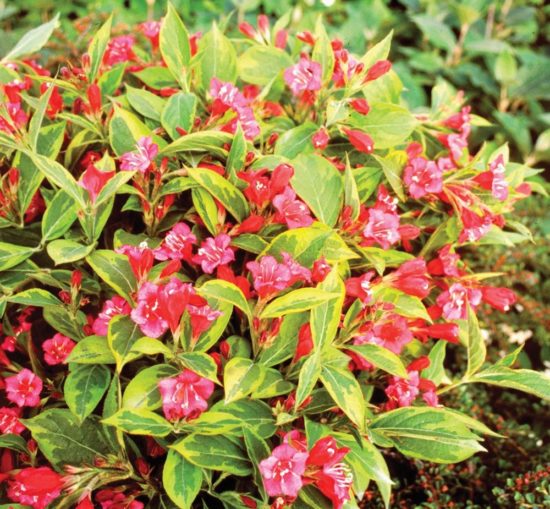
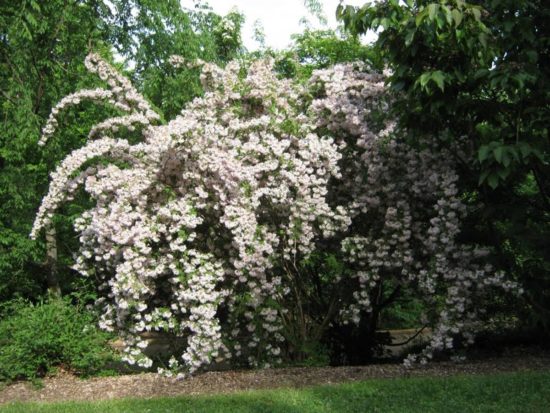
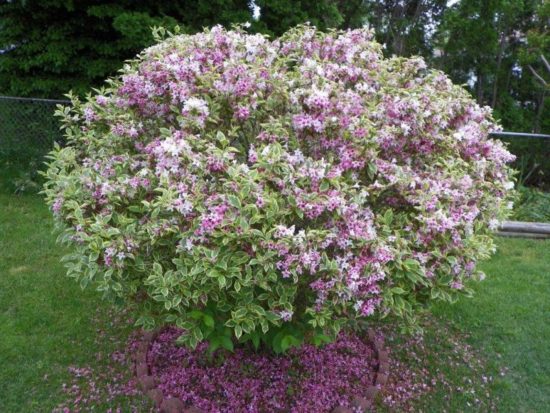
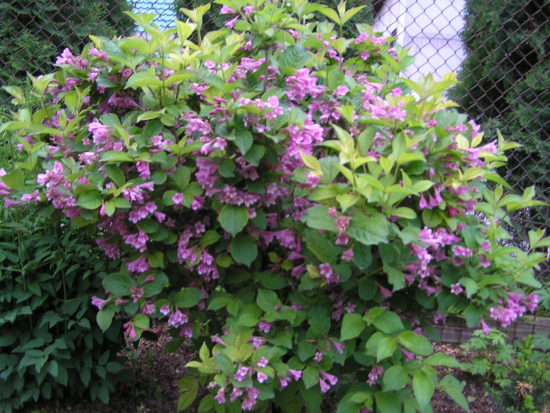
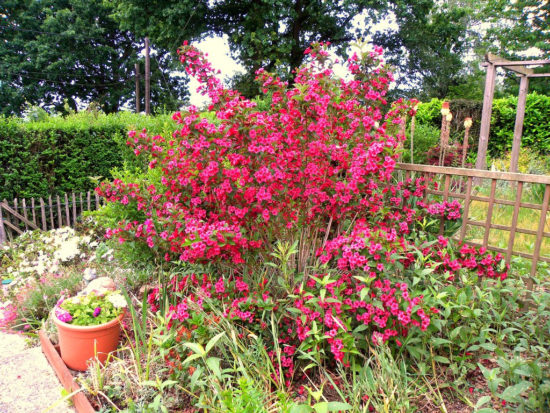
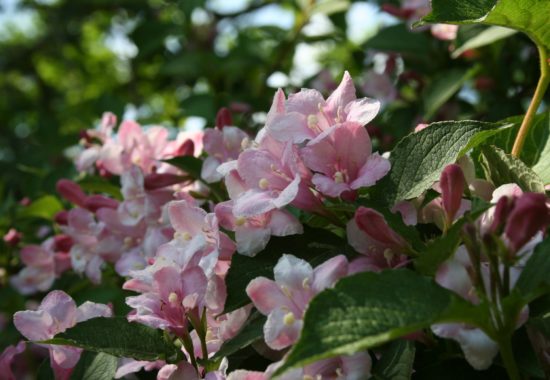
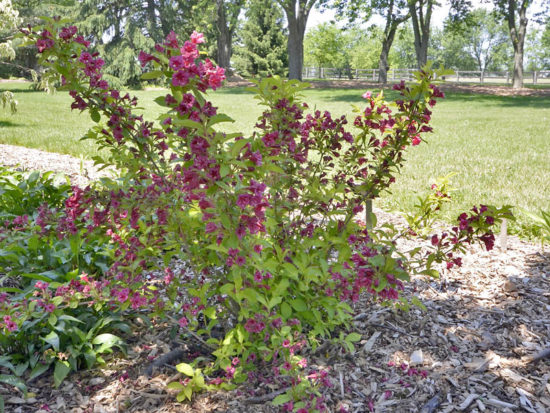
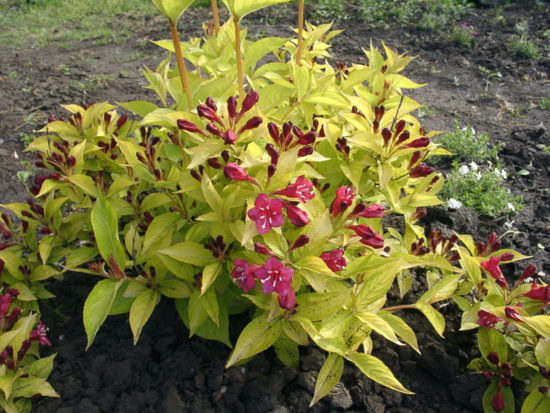
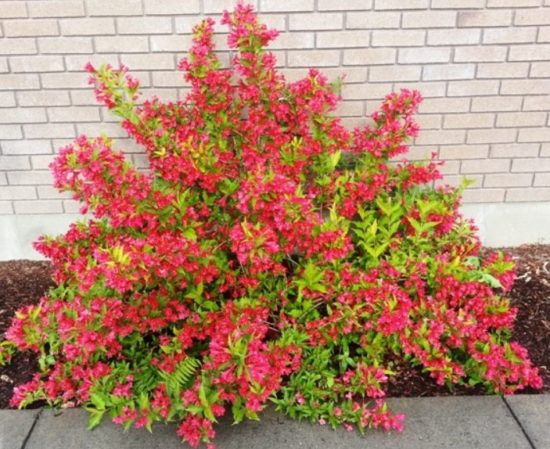
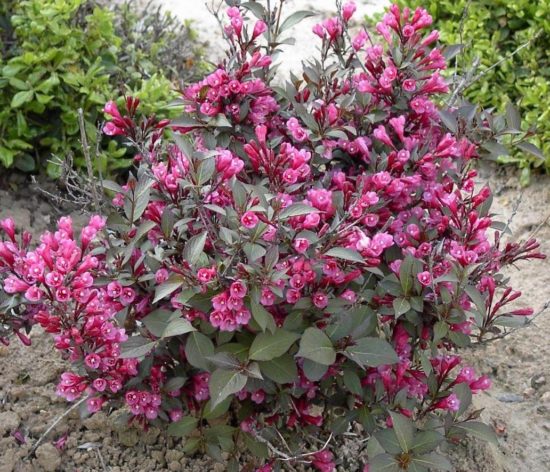

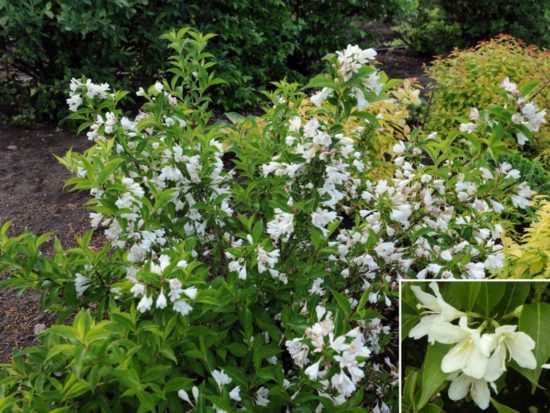
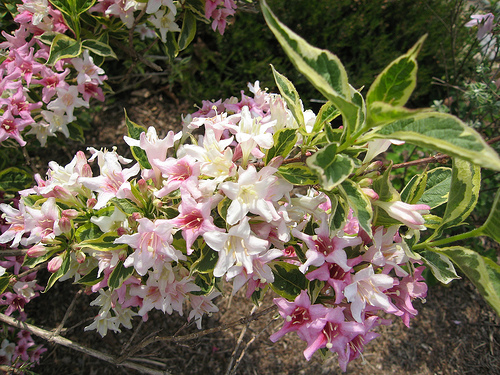
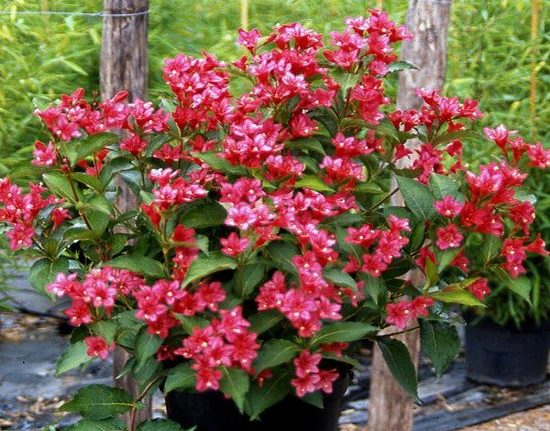
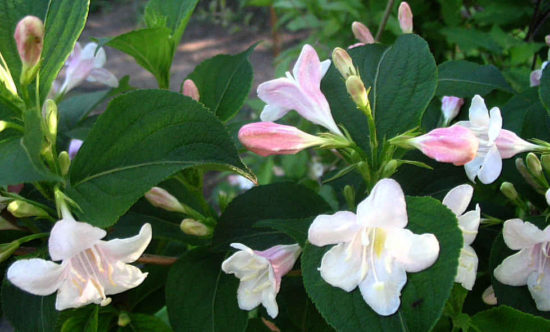
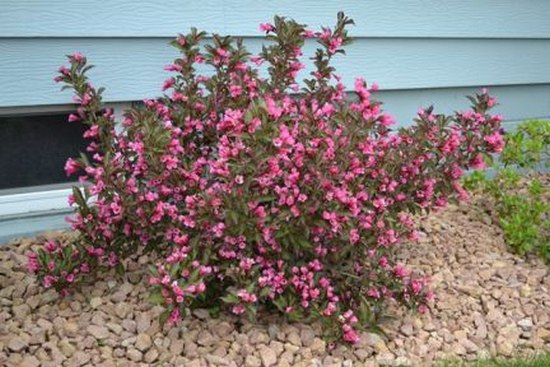
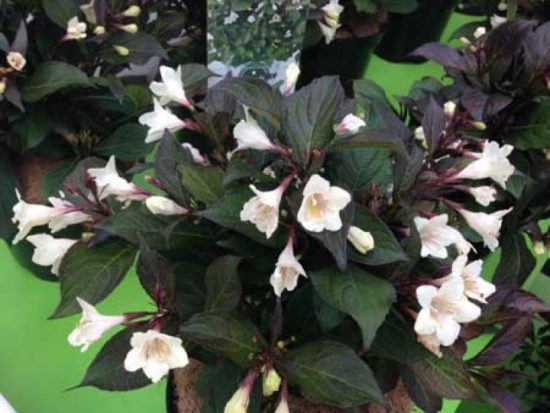
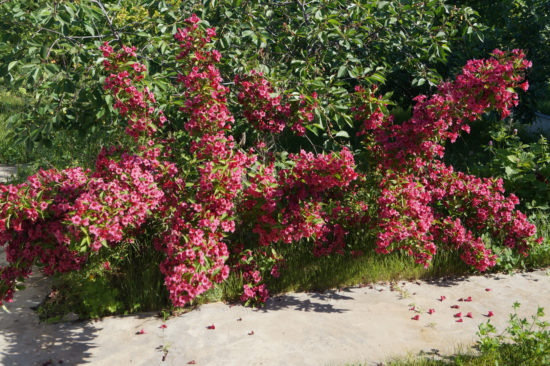
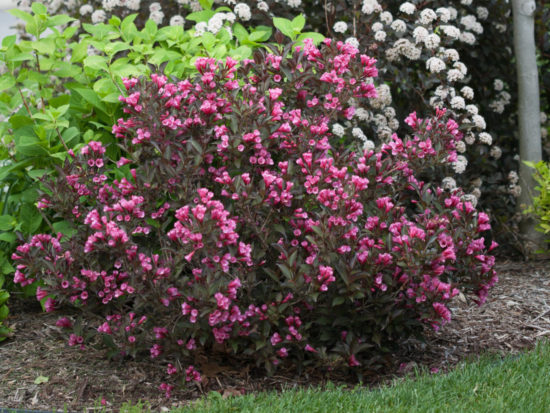
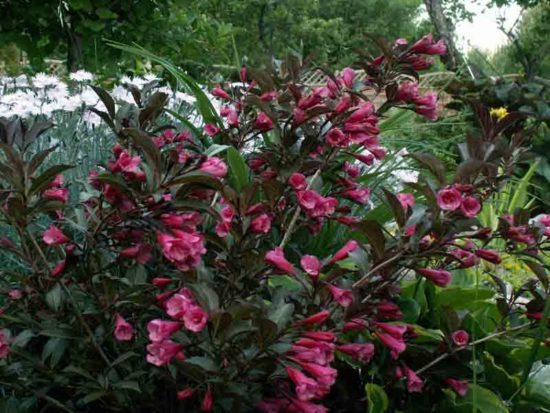


 (4 ratings, average: 3,50 out of 5)
(4 ratings, average: 3,50 out of 5) CUCUMBERS NEVER GET SICK, I'VE BEEN USING ONLY THIS FOR 40 YEARS! I SHARE A SECRET WITH YOU, CUCUMBERS ARE LIKE THE PICTURE!
CUCUMBERS NEVER GET SICK, I'VE BEEN USING ONLY THIS FOR 40 YEARS! I SHARE A SECRET WITH YOU, CUCUMBERS ARE LIKE THE PICTURE! You can dig a bucket of potatoes from each bush. Do you think these are fairy tales? Watch the video
You can dig a bucket of potatoes from each bush. Do you think these are fairy tales? Watch the video
 How our fellow gardeners work in Korea.There is a lot to learn and just fun to watch.
How our fellow gardeners work in Korea.There is a lot to learn and just fun to watch. Eye trainer. The author claims that with daily viewing, vision is restored. They don't charge money for views.
Eye trainer. The author claims that with daily viewing, vision is restored. They don't charge money for views. A 3-ingredient cake recipe in 30 minutes is better than Napoleon. Simple and very tasty.
A 3-ingredient cake recipe in 30 minutes is better than Napoleon. Simple and very tasty. Therapeutic exercises for cervical osteochondrosis. A complete set of exercises.
Therapeutic exercises for cervical osteochondrosis. A complete set of exercises. Which indoor plants match your zodiac sign?
Which indoor plants match your zodiac sign? What about them? Excursion to German dachas.
What about them? Excursion to German dachas.